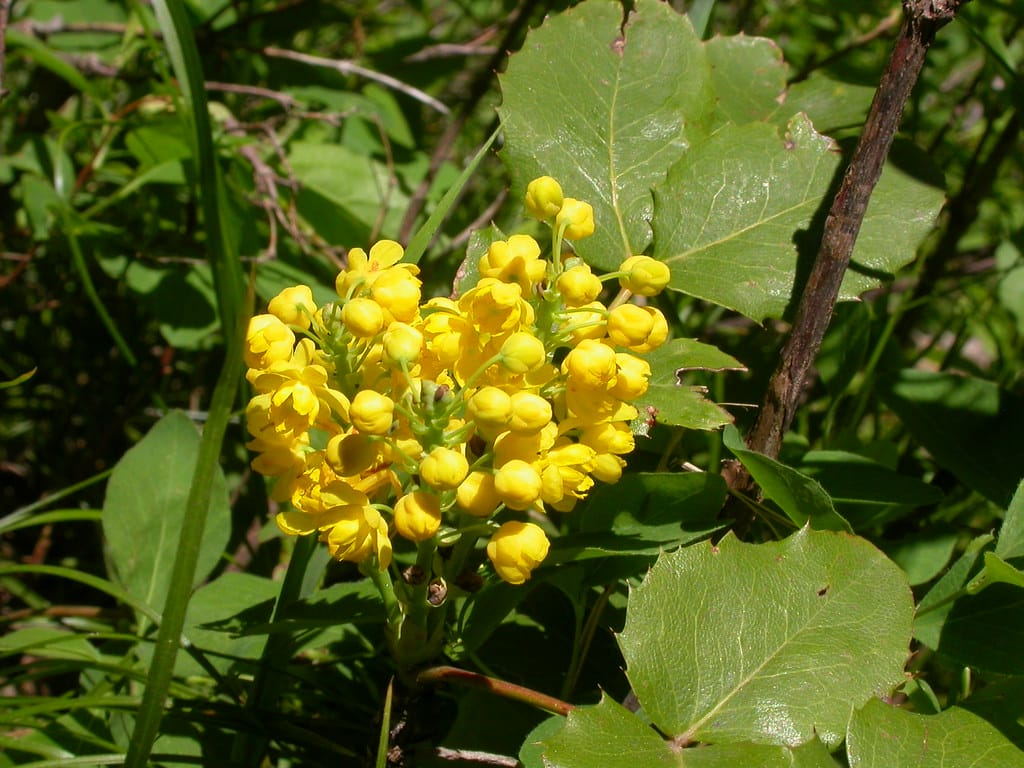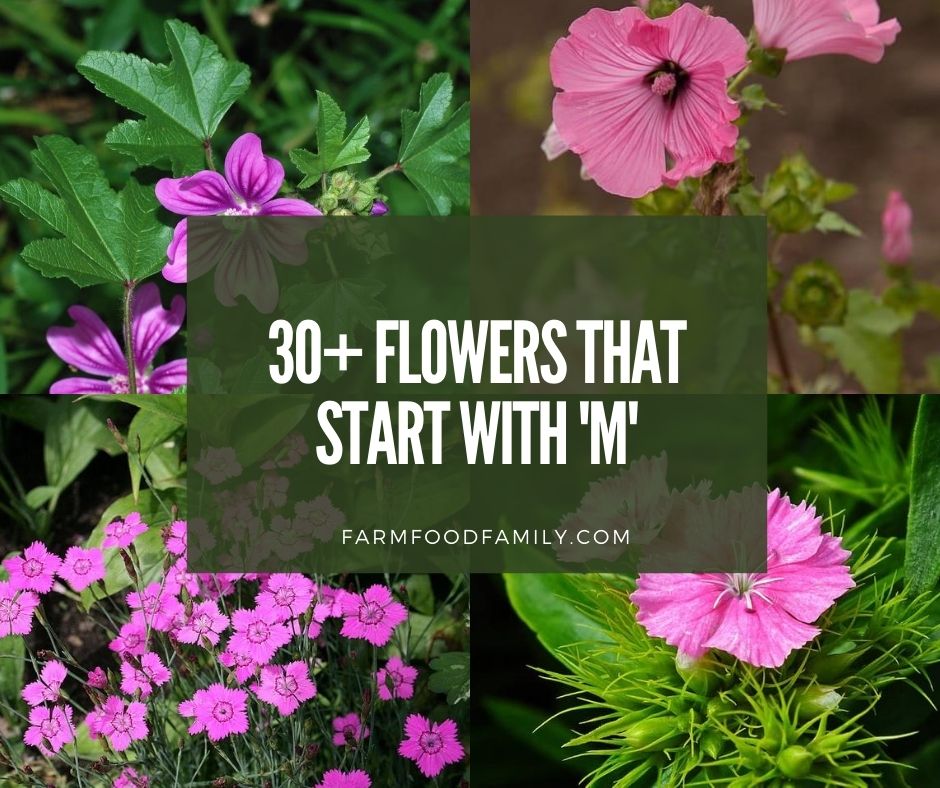At some point, you will wonder what other flowers are there that start with M other than the famous magnolias and marigolds.
And since there is no moratorium for the planting season, here are some M flowers that you could pick.
Read also:

107+ Flowers that start with ‘M’
1. Magnolia

It has more than 250 species cultivated around the world. It is loved for its velvet-textured blooms of white, pink and yellow and colored center.
It is said to have been around for 130 million years. Its species family is called Magnoliaceae. It stands for longevity and perseverance.
Read also: Magnolia flower meaning
2. Magnolia Stellata

It is native to Japan and is fondly called as the Royal Star because of its tiny, delicate, star-shaped, white flowers that bloom from late winter to mid-spring. It is the hardiest magnolia species.
3. Magnolia-Grandiflora (Southern magnolia)

It is also known as the southern magnolia. It is considered as the most fragrant magnolia. It is also distinguishable for its dark green, leathery leaves, and large white flowers blooming from spring to summer.
4. Magnolia (Magnoliaceae)
see description for Magnolia.
5. Mahonia Aquifolium

It is also called the Holly-leaved Barberry. It has broad, deep green leaves with spiny edges that turn maroon during fall. It will bloom bell-shaped, yellow flowers during spring and small dark blue fruits.
6. Mahonia Japonica

This one is fondly called as Oregon-grape holly that is native to Japan. It is drought-tolerant and blooms tiny, yellow flowers throughout the summer and can survive early winters.
7. Mahonia Nervosa

The nervosa also goes by the name low Oregon-grape or Cascade Barberry. It is not as tall as the Japonica and has smaller leaves than it too. It shares its yellow flowers and dark blue fruits.
8. Mahonia Repens (creeping mahonia, creeping Oregon grape)

This one is also called as the creeping mahonia; a broadleaf evergreen native to North America. It is a good ground cover with oval-shaped and spiny leaves. It also has dark blue fruits and yellow flowers.
9. Maiden

This one is a perennial accent flower with very tiny yellow and white flowers that bloom all summer. The maiden flower has the botanical name Patrinia gibbosa.
10. Maiden Pink (Dianthus Deltoides)

It is a perennial evergreen that is commonly used as garden cover. Its leaves and yellow/pink/white flowers grow profusely during late spring to summer.
11. Mallow (Lavatera)

It can be cultivated as a mallow tree (Lavatera maritima) and as shrub (Lavatera trimestris). Either Way, it is known for its pale lavender blooms with deep purple veins and edges. It works as an accent flower in rocky gardens and is considered as a natural pest control plant.
12. Maltese Cross (Lychnis chalcedonica)

It is a favorite border plant for sunny gardens. It has a deep-green, upright foliage topped with tiny, dense, red petals clumped at top. It is easy to grow and blooms year-round.
13. Malva

It is a perfect border plant for gardens due to its bush-type height and five-petal, cup-shaped blooms that come in lavender, white and deep pink with purple/baby pink veins.
14. Malva Australiana flower (Australian Hollyhock, Malva preissiana)

It is a perennial shrub that is also called as the Australian Hollyhock. It is distinct for its deep green, hairy, lobed leaves. It also has unique five-petaled, lavender flowers with yellow center and a cut edge.
15. Malva Mallow

It is clustered along cotton, hibiscus and okra. It is also called as the cheese plant because of its cheese-like wedges. It grows small, white flowers during spring and an edible herbal plant for digestive conditions.
16. Malva Sylvestris

It is an upright bush known for its flower spikes composed of five-petaled flowers in bright purple color and deep purple stripes in all petals. It is native to Ireland and the British Isles.
17. Malva Trimestris

This one is the tree mallow and is native to the Mediterranean. It is an annual shrub that is notable for its small, saucer-shaped white/pink flowers that bloom during summer to early fall.
18. Mammillaria Dixanthocentron

While it does not bloom, it is a compelling xeriscape element in desert regions. It is a robust, cylinder-shaped cactus with two long, yellow-colored central spines and other base spines.
19. Mammillaria Formosa

It goes by the name owl eyes and royal cross and is a cactus native to low regions of Mexico. It has six central spines that will fall off during fall (leaving only 2 central spines after). It also has beautiful white blooms with yellow veins that could survive through winter.
Read also: 26 Types of cactus
20. Mammillaria Haageana

It is a unique cactus species endemic in open, grassy areas in Mexico. It is distinguishable for its clumped heads at mature phase, pricks that are covered with white bristles and small, pink flowers that bloom around the head making them look like a crown.
21. Mammillaria Perezdelarosae

It is now considered as a critically endangered species growing along volcanic areas. It is one of the tiniest cacti with distinguishable straight, cream white and hooked central spines.
22. Mandevilla Cream (Rocktrumpet)

It is a climbing perennial which also goes by the name of Rocktrumpet. It is versatile as it could be cultivated as ground cover or as a border plant. It adds a tropical vibe to your garden with its deep-hued flowers of yellow/white with red centers and pink/red with yellow centers.
23. Mandevilla Sanderi

It is a common patio plant that can be cultivated as a vine or shrub. Its upright stem carries two to three, large, white and pink flowers that bloom through spring.
24. Mandevilla (Chilean Jasmine)

It is a semi-evergreen climber with funnel-shaped, creamy white, wide-lobed flowers. It blooms periodically during the summer and bears bean-like fruits after.
25. Magnolia Holland

It is a beautiful accent flower that looks like an open tulip. It has fragrant, six-petaled, lavender flowers with pink and red colors underneath. It is also called the Holland Rose.
26. Manzanita (Arctostaphylos)

It is known for its winding branches and is a native of California. It has wedge-shaped, pointy, bright green leaves and cup-shaped, white flowers that hang by the branch and reddish bark.
27. Marguerite Daisy (Argyranthemum)

It is an easy to grow, perennial shrub that is often confused with the Shasta daisy. It has slender, white, spaced petals and a large cushion-like, yellow center.
28. Marigold (Tagetes)

Blooming in fiery orange and red, marigolds always bring the flair in your garden bed. It has hundreds of varieties that will bloom year-round. It also repels insects and mosquitoes.
29. Mirabilis Albida (Hairy Four O’clock)
- Family: Nyctaginaceae
- Flower: fragrant
- Flower color: Pink
- Height: 1-3 feet
- Sun: full sun
- USDA zone: 3a-11
- Attracts: butterflies, bees, birds
- Soil PH: Neutral, Alkaline
- Water: average
30. Mirabilis Decipiens (Broadleaf Four O’clock)
- Family: Nyctaginaceae
- Common name: Broadleaf Four O’clock
- Sun: full sun
- Flower color: pink purple
31. Meconopsis Quintuplinervia
- Family: Papaveraceae
- Common name: harebell poppy
- Type: Perennial
- Flower color: Blue
- Sun: full sun, partial shade
- Soil pH: Neutral, Acid
- Soil Type: clay, loam
- Moisture: moist, well-drained
- Attracts: Bees
32. Mirabilis Longiflora (Sweet four-o’clock)
- Family: Mirabilis
- Scientific name: Mirabilis longiflora
- Hardiness: 9-11
- Type: Perennial
- Water: average
- Sun: full sun or partial sun
- Height: 2-3 ft.
- Soil type: Chalk, Loam
- Soil pH: acid, alkaline, neutral
33. Moss Phlox (Phlox Subulata)
- Family: Phlox
- Common Name: Moss Phlox
- Scientific Name: Phlox Subulata
- Plant Type: Perennial
- Hardiness Zone: 3 – 9
- Sun: Full Sun
- Water: Low, Medium
- Soil PH: Alkaline, Neutral (6.6 – 7.7)
- Flower Color: Red, Blue-Purple, Pink, White
- Attracts: birds, butterflies.
- Characteristics: Showy flowers
- Tolerates: deer, drought
- Height: 3 – 6 ft.
34. Mazus Pumilus Flower
- Family: Scrophulariaceae
- Common name: Japanese mazus
- Scientific name: Mazus pumilus
- Flower color: blue-purple
- Height: 10cm
35. Muscari Comosum Plumosum
- Family: Asparagaceae
- Common Name: Tassell Hyacint
- Plant Type: Bulbs
- Hardiness zone: 5-8
- Sun: full sun, partial shade
- Water: low, average
- Height: 0.5 – 0.75 ft.
- Characteristics: Showy
- Bloom time: April
- Tolerate: Deer, Clay Soil
36. Matthiola Sinuata
- Family: Brassicaceae
- Common name: Sea Stock
- Height: 60cm
- Bloom time: June – August
37. Monarda
- Family: Lamiaceae (mint)
- Scientific name: Monarda
- Common name: bee balm, horsemint, oswego tea, and bergamot
- Hardiness zone: 3-9
- Type: Perennial
- Sun: full sun, partial sun
- Height: 1-4 ft.
- Water: low, average
- Soil: Chalk, Loam, Clay
- Soil pH: acid, alkaline, neutral
- Attracts: butterflies, birds, hummingbirds
- Tolerance: deer, rabbit
- Bloom time: mid summer – early fall
- Flower color: Purple, pink, violet, red, white
38. Common Morning Glory (Ipomea purpurea)
- Family: Convolvulaceae
- Scientific name: Ipomoea purpurea
- Hardiness: 2-11
- Type: climber
- Height: 2-3m
- Sun: full sun
- Water: average
- Soil type: Chalk, loam, sand
- Soil pH: acid, alkaline, neutral
- Drainage: moist, well-drained
- Attracts: butterflies and hummingbirds
- Tolerance: deer
- Bloom time: early summer – early fall
- Flower color: pink, red, white, blue, magenta
39. Mother of thyme (Thymus serpyllum)
40. Marsh Marigold (Caltha Palustris)
41. Mugwort (Artemisia Vulgaris)
42. Meconopsis Integrifolia
43. Meconopsis Punicea
44. Mistletoe Cactus (Rhipsalis Baccifera)
45. Mediterranean sea holly (Eryngium bourgatii)
46. Matucana (Matucana Madisoniorum)
47. Mexican shrubby spurge (Euphorbia cotinifolia)
48. Myosotis
49. Matthiola Incana Iron
50. Mexican Fire Barrel (Ferocactus Pilosus)
51. Meconopsis Napaulensis
52. Mimosa (Mimosa pudica)
53. Mexican Giant Cardon (Pachycereus Pringlei)
54. Mexican Sunflower (Tithonia rotundifolia)
55. Monkshood (Aconitum Napellus)
56. Million bells (Calibrachoa)
57. Muscari Neglectum
58. Meconopsis Simplicifolia
59. Meadow sage (Salvia pratensis)
60. Missouri Coneflower (Rudbeckia Missouriensis)
61. Marsh Marigold
62. Meadow Rue (Thalictrum Delavayi)
63. Myrtle spurge (Euphorbia myrsinites)
64. Melocactus (Melocactus Ernestii)
65. Mountain Fleece (Persicaria Amplexicaulis)
66. Moonflower (Ipomea alba)
67. Melocactus (Melocactus Zehntneri)
68. Matthiola Incana Alba
69. Mitra (Astrophytum myriostigma nudum)
70. Mountain Laurel (Kalmia Latifolia)
71. Matthiola Fruticulosa
72. Mountain Bluet (Centaurea Montana Amethyst in Snow)
73. Meconopsis Betonicifolia
74. Mimosa Hostilis
75. Muscari Azureum
76. Muscari Latifolium
77. Mealycup sage (Salvia farinacea)
78. Melocactus (Melocactus Bahiensis)
79. Mexican Marigold
80. Myrtle Plant (Myrtus Communis)
81. Muscari Armeniacum
82. Meadow bistort (Persicaria bistorta)
83. Mayflower (Trailing Arbutus)
84. Meconopsis Horridula
85. Maximilian sunflower (Helianthus maximiliani)
86. Mina lobata (Spanish Flag)
87. Missouri Foxtail Cactus (Escobaria Missouriensis)
88. Mondo Grass (Ophiopogon Planiscapus)
89. Morning Glory (Convolvulus tricolor)
90. Michaelmas Daisy (Aster Celeste)
91. Musk mallow (Malva moschata)
92. Moss Rose (Portulaca grandiflora)
93. Miss Willmott’s ghost (Eryngium giganteum)
94. Muscari (Grape Hyacinth)
95. Meadow Rue (Thalictrum Aquilegiifolium)
96. Matucana (Matucana Aureiflora)
97. Meconopsis (Blue Himalayan Poppy)
98. Missouri Evening Primrose (Oenothera Macrocarpa)
99. Meadow Rue (Thalictrum Kiusianum)
100. Milkweed
101. Mexican bush sage (Salvia leucantha)
102. Matthiola (Stock Flower)
103. Mirabilis Jalapa
104. Moss stonecrop (Sedum acre)
105. Mazus (Mazus Reptans)
106. Mock Orange (Philadelphus)
107. Marvel of Peru (Mirabilis jalapa)
Conclusion
Having M-initialed only flowers as a garden theme would make a unique and interesting garden façade. With all of these flowers that start with letter M on this list, you will not fall short of garden picks.

